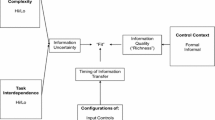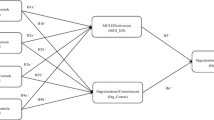Abstract
This paper investigates theories that integrate and extend currently accepted agency- and transaction-based approaches to organizational control. We use a computational model to build three forms of control systems (market, bureaucratic, clan) and three forms of control targets (input, behavior, output). Using these models, we examine relationships between control systems and both singular and multiple control targets. Results of this study support the emerging “broader” perspective on organizational control research and suggest that managers can improve organizational performance by focusing attention on multiple control targets. In addition, findings partially support posited relationships between control systems and singular control targets. The authors suggest that results of this study should direct scholars to refocus control research from examinations of singular forms of control to evaluations of more complex control systems.
Similar content being viewed by others
References
Barney, J.B. and W. Hesterly (1996), “Organizational Economics: Understanding the Relationship Between Organizations and Economic Analysis,” in S.R. Clegg, C. Hardy and W.R. Nord (Eds.) Handbook of Organization Studies. Sage Publications, Thousand Oaks, CA.
Barney, J. and W. Ouchi (1986), Organizational Economics. Jossey-Bass, San Francisco, CA.
Bradach, R. and E. Eccles (1989), “Price, Authority, and Trust,” Annual Review of Sociology, 15, 97–118.
Burton, R.M. and B. Obel (1980), “A Computer Simulation to Test the M-Form Hypothesis,” Administrative Science Quarterly, 25, 1–32.
Cardinal, L.B. (2001), “Technological Innovation in the Pharmaceutical Industry: Managing Research and Development Using Input, Behavior, and Output Controls,” Organization Science, 12, 19–36.
Cardinal, L.B., S.B. Sitkin and C.P. Long (1999), “Mixing Oil andWater: Sequencing Control System Adaptation to Create Effective Integrative Control Mechanisms,” paper presented at the Strategic Management Society, 19th Annual International Conference, Berlin, Germany.
Cardinal, L.B., S.B. Sitkin and C.P. Long (2002a), “Balancing and Rebalancing in the Creation and Evolution of Organizational Control,” Working Paper.
Cardinal, L.B., S.B. Sitkin and C.P. Long (2002b), “Creating Control Configurations During Organizational Founding,” Working Paper.
Carley, K. (1992), “Organizational Learning and Personnel Turnover,” Organization Science, 3, 20–46.
Carroll, T.N. and R.M. Burton (2000), “Exploring Complex Organizational Designs,” Computational and Mathematical Organization Theory, 6, 339–360.
Cyert, R.M. and J.G. March (1963), A Behavioral Theory of the Firm. Prentice-Hall, Englewood Cliffs, NJ.
Daft, R. (1998), Organization Theory and Design. South-Western College Publishing, Cincinnati, OH.
Donaldson, L. (1990), “The Ethereal Hand: Organizational Economics and Management Theory,” Academy of Management Review, 15, 369–381.
Eisenhardt, K.M. (1985), “Control: Organizational and Economic Approaches,” Management Science, 31, 134–149.
Eisenhardt, K.M. (1989), “Agency Theory: An Assessment and Review,” Academy of Management Review, 31, 57–74.
Fama, E. (1980), “Agency Problems and the Theory of the Firm,” Journal of Political Economy, 88, 288–307.
Folger, R., M.A. Konovsky and R. Cropozano (1992), “A Due Process Metaphor for Performance Appraisal,” Research in Organizational Behavior, 14, 129–177.
Galbraith, J.R. (1973), Designing Complex Organizations. Addison-Wesley, Reading, MA.
Galbraith, J.R. (1977), Organization Design. Addison-Wesley, Reading, MA.
Ghoshal, S. and P. Moran (1996), “Bad for Practice: A Critique of the Transaction Cost Theory,” Academy of Management Review, 1, 13–47.
Jaworski, B.J. (1988), “Toward a Theory of Marketing Control: Environmental Context, Control Types, and Consequences,” Journal of Marketing, 52, 23–39.
Jaworski, B.J., V. Stathakopoulos and H.S. Krishnan (1993), “Control Combinations in Marketing: Conceptual and Empirical Evidence,” Journal of Marketing, 57, 57–69.
Jensen, M. and W. Meckling (1976), “Theory of the Firm: Managerial Behavior, Agency Costs, and Ownership Structure,” Journal of Financial Economics, 3, 305–360.
Jin, Y. and R.E. Levitt (1996), “The Virtual Design Team: A Computational Model of Project Organizations,” Computational and Mathematical Organization Theory, 2, 171–196.
Harrison, J.R. and G.R. Carroll (1991), “Keeping the Faith: A Model of Cultural Transmission in Formal Organizations,” Administrative Science Quarterly, 36, 552–582.
Kaplan, R.S. and D.P. Norton (1992), “The Balanced Scorecard-Measures That Drive Performance,” Harvard Business Review, 70, 71–79.
Kirsch, L.J. (1996), “The Management of Complex Tasks in Organizations: Controlling the Systems Development Process,” Organization Science, 7, 1–21.
Lebas, M. and J. Weigenstein (1986), “Management Control: The Roles of Rules, Markets, and Culture,” Journal of Management Studies, 23, 259–272.
Lewin, A.Y. and C.U. Stephens (1994), “CEO Attributes as Determinants of Organization Design,” Organization Studies, 15, 183–212.
Long, C.P. (2002), “Balancing Organizational Controls with Trust-Building and Fairness-Building Initiatives,” Ph.D. dissertation, Duke University.
March, J.G. (1991), “Exploration and Exploitation in Organizational Learning,” Organization Science, 2, 71–87.
March, J.G. and H.A. Simon (1958), Organizations. Wiley, New York, NY.
Merchant, K.A. (1985), Control in Business Organizations. Pitman Publishing, Marshfield, MA.
Merchant, K.A. (1988), “Progressing Toward a Theory of Marketing Control: A Comment,” Journal of Marketing, 52, 40–44.
Mihavics, K. and A.M. Ouksel (1996), “Learning to Align Organizational Design and Data,” Computational and Mathematical Organization Theory, 1, 143–155.
Noorderhaven, N.G. (1992), “The Problem of Contract Enforcement in Economic Organization Theory,” Organization Studies, 13, 292–243.
Ouchi,W.G. (1977), “The Relationship Between Organizational Structure and Organizational Control,” Administrative Science Quarterly, 22, 95–113.
Ouchi, W.G. (1979), “A Conceptual Framework for the Design of Organizational Control Mechanisms,” Management Science, 25, 833–848.
Ouchi, W.G. (1980), “Markets, Bureaucracies, and Clans,” Administrative Science Quarterly, 25, 129–141.
Ouchi, W.G. (1981), Theory Z: How American Business Can Meet the Japanese Challenge. Addison-Wesley, Reading, MA.
Ouchi, W.G. and M.A. Maguire (1975), “Organizational Control: Two Functions,” Administrative Science Quarterly, 20, 559–569.
Ouksel, A. and R. Vyhmeister (2000), “Performance of Organizational Design Models and Their Impact on Organizational Learning,” Computational and Mathematical Organization Theory, 6, 395–410.
Pettigrew, A.M. (1979), “On Studying Organizational Cultures,” Administrative Science Quarterly, 24, 570–581.
Phelan, S.E. and Z. Lin (2001), “Promotion Systems and Organizational Performance: A Contingency Model,” Computational and Mathematical Organization Theory, 7, 207–232.
Quinn, R.E. (1988), Beyond Rational Management: Mastering the Paradoxes and Competing Demands of High Performance. Jossey-Bass, San Francisco, CA.
Roth, N.L., S.B. Sitkin and A. House (1994), “Stigma as a Determinant of Legalization,” in S.B. Sitkin and R.J. Bies (Eds.) The Legalistic Organization. Sage Publications, Thousand Oaks, CA, pp. 137–168.
Simons, R. (1995), Levers of Control: How Managers Use Innovative Control Systems to Drive Strategic Renewal. Harvard Business School Press, Boston, MA.
Snell, S.A. (1992), “Control Theory in Strategic Human Resource Management: The Mediating Effect of Administrative Information,” Academy of Management Journal, 35, 292–327.
Snodgrass, C.R. and E.J. Szewczak (1990), “The Substatutability of Strategic Control Choices: An Empirical Study,” Journal of Management Studies, 27, 535–553.
Sutcliffe, K.M., S.B. Sitkin and L.D. Browning (2000), “Tailoring Process Management to Situational Requirements: Beyond the Control and Exploration Dichotomy,” in R. Cole and W.R. Scott (Eds.) The QualityMovement and Organizational Theory. Sage Publications, Thousand Oaks, CA, pp. 315–330.
Thompson, J.D. (1967), Organizations in Action. McGraw-Hill, New York, NY.
Weber, M. (1946), From Max Weber: Essays in Sociology, H.H. Gerth and C.W. Mills (Translators). Oxford University Press, New York, NY.
Wilkins, A.L. and W.G. Ouchi (1983), “Efficient Cultures: Exploring the Relationship Between Culture and Organizational Performance,” Administrative Science Quarterly, 28, 468–481.
Williamson, O.E. (1975), Market and Hierarchies: Analysis and Antitrust Implications. Free Press, New York, NY.
Wong, S. and R.M. Burton (2000), Virtual Teams: What Are Their Characteristics and Impact on Team Performance,” Computational and Mathematical Organization Theory, 6, 319–337.
Author information
Authors and Affiliations
Rights and permissions
About this article
Cite this article
Long, C.P., Burton, R.M. & Cardinal, L.B. Three Controls are Better than One: A Computational Model of Complex Control Systems. Computational & Mathematical Organization Theory 8, 197–220 (2002). https://doi.org/10.1023/A:1020767513183
Issue Date:
DOI: https://doi.org/10.1023/A:1020767513183




